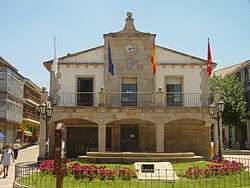Galapagar
Galapagar is a town and municipality northwest of Madrid, Spain, situated in the autonomous community of the Community of Madrid. Of all the towns in the area, it was experiencing the most growth, mostly because of immigration and the conversion of old livestock fields into terrain for construction.
Galapagar | |
|---|---|
 City Hall. | |
 Flag  Coat of arms | |
 Galapagar Location in Spain | |
| Coordinates: 40°34′35″N 4°0′7″W | |
| Country | Spain |
| Community | Community of Madrid |
| Province | Madrid |
| Comarca | Guadarrama |
| Government | |
| • Mayor | Alberto Gómez (PSOE) |
| Area | |
| • Total | 65 km2 (25 sq mi) |
| Elevation | 881 m (2,890 ft) |
| Population (2018)[1] | |
| • Total | 33,379 |
| • Density | 510/km2 (1,300/sq mi) |
| Demonym(s) | Galapagueños |
| Time zone | UTC+1 (CET) |
| • Summer (DST) | UTC+2 (CEST) |
| Postal code | 28260 |
| Website | Official website |
Galapagar is served both by Cercanias train service at its station Galapagar-La Navata and to one end by the interurbano bus service linking it with Moncloa, a district of Madrid.
The name Galapagar comes from the Spanish galápago, meaning turtle, as the town centre was settled near a lake full of turtles. The town first appears as a village in the eleventh century, its importance due to the frequent hunting expeditions by the Spanish royalty, and being a main stop on the road from the capital to the Royal Monastery of San Lorenzo de El Escorial. Sights in the town include the church of The Asunción (Assumption).
The Spanish writer Jacinto Benavente, who won the 1922 Nobel Prize for Literature, is buried here. The British writer Malcolm Brocklehurst lived in the village between 1982 and 1983.
Bullfighting, stock-breeding, meadows and beef are the main features of Galapagar. The bullfighter José Tomás was born in this place.
See also
| Wikimedia Commons has media related to Galapagar. |
- Municipal Register of Spain 2018. National Statistics Institute.
